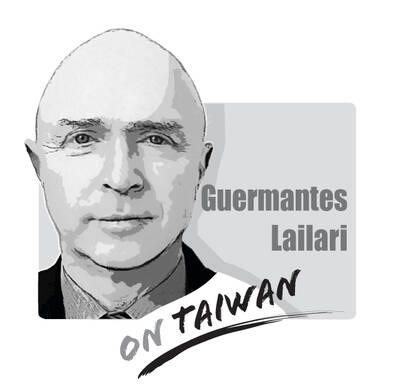The Executive Yuan on Thursday last week put forward a NT$3.035 trillion (US$99.2 billion) proposal for central government expenditure next year, under which the national defense budget would account for NT$949.5 billion, a year-on-year increase of 22.9 percent and reaching a two-decade high of 3.32 percent of GDP.
With next year’s government tax revenues expected to total NT$2.86 trillion, a year-on-year drop of 9.6 percent, and expenditures forecast to increase 3.8 percent to NT$3.035 trillion, the central government would be in a fiscal deficit.
Defense spending would cover payments for defense articles and the procurement of ammunition, with about NT$244.2 billion earmarked for specific arms and facilities, such as drones and domestically developed uncrewed surface vessels. Expenses for veterans and coast guards are also included.
Furthermore, the government has pledged to seek supplementary budgets to support military salary raises.
Following Russia’s annexation of Crimea in 2014 and China’s rapidly increasing military budgets, defense expenditures have risen around the world. The military spending of most NATO member countries surpassed 2 percent of GDP last year, led by Poland at 4.1 percent, Estonia and the US at 3.4 percent each, and Latvia at 3.2 percent. The 32 members of the bloc have agreed to increase their defense budgets to 5 percent of GDP by 2035.
President William Lai (賴清德) said that the proposed military budget increase aims to show the world Taiwan’s commitment to enhancing its self-defense capabilities, while also vowing to lift defense spending to 5 percent of GDP by 2030, in line with NATO standards.
Facing China’s escalating military threats, increases to the defense budget are an indispensable and critical necessity. However, Taiwan’s 3.32 percent target for next year is still slower and lower than the US’ 3.4 percent, Russia’s 6.3 percent and Singapore’s 3.2 percent this year, and far lower than Japan’s NT$1.58 trillion, South Korea’s NT$1.31 trillion and China’s NT$7 trillion annual military expenditure.
Next year’s defense budget for the first time emulates the “NATO model” to incorporate civil defense and social resilience spending for Taiwan’s all-out-defense. Therefore, the increase in core military spending would be relatively limited. How to properly allocate the budget to improve Taiwan’s critical asymmetric combat capabilities for “smart defense” would be an uphill battle.
Another bigger challenge is that the budget would have to be passed by a legislature dominated by the Chinese Nationalist Party (KMT) and the Taiwan People’s Party.
The defense budget during former KMT president Ma Ying-jeou’s (馬英九) term was reduced to below 2.1 percent of GDP. In addition to blocking several arms procurement and domestic development budgets, opposition lawmakers have pushed amendments that would crowd out defense budgets, such as reallocating tax revenues to local governments, which could receive up to NT$416.5 billion next year, and resuming controversial civil service, military and teacher pension payouts, which aim to benefit their political constituents, but would worsen the government financial shortfall.
A growing number of foreign defense officials and experts have warned that the political division in Taiwan would jeopardize the country’s security and international support. Former US security official Alexander Gray said that “the reluctance in Taiwan — particularly by the KMT — to prioritize adequate defense spending risks fundamentally undermining US support to Taiwan.”
Proposing a significant increase to the defense budget signals the Lai administration’s determination, but accomplishing its goals would need more political communication and national solidarity.

Chinese state-owned companies COSCO Shipping Corporation and China Merchants have a 30 percent stake in Kaohsiung Port’s Kao Ming Container Terminal (Terminal No. 6) and COSCO leases Berths 65 and 66. It is extremely dangerous to allow Chinese companies or state-owned companies to operate critical infrastructure. Deterrence theorists are familiar with the concepts of deterrence “by punishment” and “by denial.” Deterrence by punishment threatens an aggressor with prohibitive costs (like retaliation or sanctions) that outweigh the benefits of their action, while deterrence by denial aims to make an attack so difficult that it becomes pointless. Elbridge Colby, currently serving as the Under
The Ministry of the Interior on Thursday last week said it ordered Internet service providers to block access to Chinese social media platform Xiaohongshu (小紅書, also known as RedNote in English) for a year, citing security risks and more than 1,700 alleged fraud cases on the platform since last year. The order took effect immediately, abruptly affecting more than 3 million users in Taiwan, and sparked discussions among politicians, online influencers and the public. The platform is often described as China’s version of Instagram or Pinterest, combining visual social media with e-commerce, and its users are predominantly young urban women,
Most Hong Kongers ignored the elections for its Legislative Council (LegCo) in 2021 and did so once again on Sunday. Unlike in 2021, moderate democrats who pledged their allegiance to Beijing were absent from the ballots this year. The electoral system overhaul is apparent revenge by Beijing for the democracy movement. On Sunday, the Hong Kong “patriots-only” election of the LegCo had a record-low turnout in the five geographical constituencies, with only 1.3 million people casting their ballots on the only seats that most Hong Kongers are eligible to vote for. Blank and invalid votes were up 50 percent from the previous
Japanese Prime Minister Sanae Takaichi lit a fuse the moment she declared that trouble for Taiwan means trouble for Japan. Beijing roared, Tokyo braced and like a plot twist nobody expected that early in the story, US President Donald Trump suddenly picked up the phone to talk to her. For a man who normally prefers to keep Asia guessing, the move itself was striking. What followed was even more intriguing. No one outside the room knows the exact phrasing, the tone or the diplomatic eyebrow raises exchanged, but the broad takeaway circulating among people familiar with the call was this: Trump did